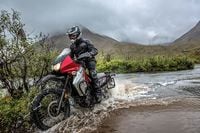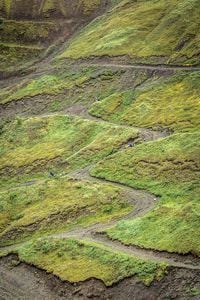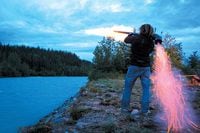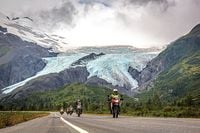Alaska has been on my bucket list since I took my first big road trip at 18. I sketched out an itinerary a few times over the years, but there never seemed to be a big enough hole in my calendar to fit the trip. It's 3,500 miles from Los Angeles to Anchorage; it would take a week just to get there.
My flight to Anchorage took just five hours. I'd never even considered a fly-and-ride package—not my style, way too touristy, and probably way too much hand holding. But the format fit my busy schedule, and MotoQuest's "Industry Invitational" didn't sound like some bubble-wrapped adventure. The nightly camping meant I'd get to exercise some independence and self-reliance, and then there was this doozy of a disclaimer: "This ride is not for wimps. Riders must be physically fit, mentally strong, and able to cope with adversity." Nice. If there were going to be any hand holding on this trip, it would only be when someone helped you up off the ground!
The walls of MotoQuest's headquarters in Anchorage (population 300,000) are covered in thank-you notes, maps, spectacularly worn-out parts, and other mementos from epic rides. Cold drizzle fell on the 20-odd participants as we packed Pelican cases and lashed camping equipment to our rented dual sports. My bike, a second-generation Kawasaki KLR650 with scarred crash bars, registered 22,526 miles on the odometer. "It was new last season," MotoQuest's Kevin Hagerty said. The riding season is short in Alaska, but MotoQuest makes the most of it. This end-of-summer trip is an annual affair—a relaxed, last hurrah for the MotoQuest team before they sell off their hammered rental fleet and hunker down for the winter.
We departed Anchorage under roiling clouds, heading northeast along the Matanuska River on the Glenn Highway. Mountains jutted up around us, and through the fog I glimpsed the first of many glaciers sagging from a gap in a ridge, the ice gleaming pale blue against a landscape of gray.
Continuing east, we emerged from the mountains onto a plateau of alpine tundra. I had imagined Alaska as a land of towering forests, but the summers are brief and the winters so long and brutally cold that trees have precious little chance to grow.
We fueled up in Glennallen (population 483), notable for the fact that it boasts a cell phone tower and more than one gas pump. "Call your sweethearts now," Kevin suggested. "This is the last chance you'll get for a while."
That night we pitched our tents along the bank of the Klutina River in Copper Center (population 328). The town enjoyed a brief period of importance during the Klondike Gold Rush, but today it's little more than a garage, a restaurant, and a bunkhouse. The entire town appears to be owned by Tom, a hulk of a man who is a mechanic, restaurant manager, innkeeper, and peacekeeper.
At camp that evening we're joined by MotoQuest founder Phil Freeman, fresh off a tour in Iceland. We drank beer by the campfire, and when he sensed the time was right, MotoQuest General Manager Brenden Anders brought out the fireworks and potato cannon. Who knew a sack of russets, a can of Aqua Net, and a length of PVC could be so entertaining? We lobbed spuds over the river until the igniter shattered, and then we repurposed the cannon as a bazooka, feeding rockets down the barrel and launching them upriver toward another camp armed with mortars and Saturn batteries. They continued to return fire well after we ran out of ammo. I crawled into my tent reeking of wood smoke and sulfur, eager for the next day's ride to begin.
Then next morning the carbureted KLRs cranked to life more readily than some of the riders. At breakfast, Tom informed us that there was now a 10 p.m. curfew on fireworks.
Our destination for the day was Valdez (population 3,976), famous as Alaska's oil faucet. The scenery along the way rivaled anything I've seen in the Alps. Jagged, snow-capped mountains—including several of the highest peaks on the continent—served as the backdrop to an endless series of sweeping curves unwinding before our wheezing, wallowing machines. Rounding a bend, Worthington Glacier dominated the view, sliding down toward the road like a half-melted scoop of ice cream. Hiking toward the ice, I could feel the dense, super-cooled air flowing off the ancient glacier.
As we traveled south, the mountains shouldered in close to the road, rising to sheer cliffs streaked with waterfalls trailing ribbons of mist. Twelve-foot snowplow guideposts lined the road over Thomson Pass, a reminder of the area's status as the snowiest place in Alaska. On average, the pass receives almost 50 feet of the stuff per year.
In Valdez, monolithic mountains crowd the harbor, protruding from the coastal marshlands to neck-straining heights. We rode all the way around the port, past creeks overflowing with spawning salmon to the terminus of the Trans-Atlantic Pipeline. On the way out of town, we took a detour up a steep, lush canyon and got our first taste of Alaskan dirt, sliding, splashing, and wheelying our bikes up the muddy road. Where the road ended stood a massive metal sign blasted bare by bullets of every caliber. Perforated signage is common in Alaska. Either the locals don't have enough targets to shoot at, or they're not fond of directives. Likely, it's both.
Back at camp, we started in on what would become a nightly ritual of beer drinking, bike fixing, and fire building.
The following day we broke into two groups. I joined the party headed to the abandoned Nabesna Mine deep in the Wrangell-St. Elias National Park. The road into the park's interior is well-graded gravel, and we barreled along it at top speed, flat-tracking through corners and slowing only for water crossings. When the road came to an end at a grass airstrip we forged on and eventually came upon a conglomerate of buildings atop a massive tailing pile streaked tan and gray—the Nabesna Gold Mine.
I climbed over collapsed machinery, looked through drawers of plumbing fittings, peered down dry sluiceways, and even climbed the rafters to the rooftop tramway tower. "When my wife said don't do anything stupid in Alaska," I told Motorcycle Superstore's Greg Anderson, who had accompanied me the three stories up to the top of the building, "I'm pretty sure this is exactly what she meant!" Rather than climbing down the way we came, Greg and I slid down an exposed pipe on the building's exterior, fireman style.
An early morning out-and-back off-road flog with Butler Maps' Justin Bradshaw meant I missed the group's exodus from Copper Center, so I traveled north alone as Justin headed back to Anchorage for an early departure. I was chilled to the core by the time I got to Paxson (population 40), where I swung my KLR west onto the legendary Denali Highway.
Highway is a misnomer in Alaska, especially when it comes to the Denali. Your typical thoroughfare in the lower 48 has gas stations, rest areas, and restaurants. Like most of Alaska, the Denali is desolate: no signs, power lines, or pavement, for that matter. It's just you and the caribou and a few spots of civilization, such as the Gracious House Lodge at mile marker 82, where I finally caught up with the MotoQuest group. The Gracious House compound is complete with an airstrip, fuel station, café, generator room, and "cabins" fashioned from old shipping containers. It's a rustic outpost, and it served as our base camp for several days of epic off-road riding.
Over the next two days we explored mining claims and valleys via trails ranging from crude to non-existent, held impromptu hill climbs on glacial moraines, forded literally dozens of creeks, bashed across rock slides, rode along river banks, and picked our way along ridge tops just below the snowline.
The rain hadn't abated for more than a few hours all week, and the creeks ran high as a result, making crossings especially exciting. At one deep, fast-moving crossing, we lost literally half the bikes to the current, and had to wade thigh deep to drag out riders and bikes. We spent well over an hour "de-aquaing" KLRs before we could continue.
High on adrenaline and pure Alaskan air, Greg, AltRider's Jeremy Lebreton, and I raced ahead up the valley. Midway up a series of switchbacks on the valley wall we spotted a mineshaft. Clambering past the timbers blocking the entrance, we trudged into the tunnel through ankle-deep water, only turning back when we encountered a cave-in and only after switching off my flashlight so we could stand in true, complete darkness for a moment.
We rallied hard on the ride out. Those of us who were invigorated by the challenging terrain raged at full throttle, but we may have let our excitement overrule our judgment. The wet gravel and dirt yielded spectacular traction, but we still crashed, some of us repeatedly, and hard enough to shear footpegs and crash bars.
Back at the Gracious House, we set to work. It was triage in the hangar, with all hands on deck to repair the mangled bikes. There were broken bolts, bent bars, blown fork seals, and fried wiring harnesses to attend to. More than a few crankcase sight glasses looked to contain 2-percent milk. Tom Halavik from Twisted Throttle helped me fix my bike's fork while a trio of guys with a big hammer and bigger pry bar set about straightening one KLR's crash cage. To say we were hard on equipment would be an understatement, but the beauty of the KLR is that it's brutally rugged and easy to repair.
After fixing the bikes we lit a campfire and had a Roman candle battle in the rain, then celebrated MotoQuest mechanic Andy Covell's birthday with way too much Crown Royal. While the rest of the gang went to the Sluice Box Bar to continue the party, I crawled into my tent and fell asleep, incredibly exhausted but utterly contented.
But the fun had to end, and my flight back to Los Angeles was an early one. The next morning I broke camp early, loaded the KLR, said goodbye to those already awake, and was off, flying down the Denali. The sky was the clearest I'd seen yet, and the fair weather revealed massive vistas that had evaded us all week.
By the time I got back to Anchorage, my bike's trip meter read just 117 miles; the speedometer cable had snapped early on the first day. Flying into this trip, I was worried it would be too tame, but I walked onto my return flight feeling sore and satisfied. In total we rode almost 1,500 miles, about a quarter of which were dirt. What a wild, lonesome, vast place Alaska is. And although I just scratched the surface, I got to scratch Alaska off my bucket list at long last.
Motoquest offers more civilized tours all over the world; log on to motoquest.com to plan your own epic ride.
People travel from all over the world to experience the Stelvio Pass in the Italian Alps, but the best part of Strada Statale 38 is arguably the descent to Bormio. So after you've joined the conga line climbing Stelvio's 48 switchbacks, make sure you continue on over the mountain.
The backside of the pass has smoother pavement, less traffic, better scenery, much better rhythm, and it's longer, too. Enjoy the view as you carve through the gentle switchbacks of the upper valley, then focus up as the road narrows and dives in and out of a cliff through tunnels carved into the rock. As with any road in the Alps there are plenty of hairpins, and since you're descending you get to enjoy the view of the valley instead of just looking up at the stone retaining wall below the next corner.
—Ari Henning


















/cloudfront-us-east-1.images.arcpublishing.com/octane/S35YGSEMEZB4BLTDJTSZPF4GLA.jpg)
/cloudfront-us-east-1.images.arcpublishing.com/octane/5UOT6HPX2JFMRJAX6EH45AR4MQ.jpg)
/cloudfront-us-east-1.images.arcpublishing.com/octane/OKWOJWAKP5EP3OACCRRWPCIX2Q.jpg)
/cloudfront-us-east-1.images.arcpublishing.com/octane/2WF3SCE3NFBQXLDNJM7KMXA45E.jpg)
/cloudfront-us-east-1.images.arcpublishing.com/octane/G4MG6OUCJNBSHIS2MVVOTPX65E.jpg)
/cloudfront-us-east-1.images.arcpublishing.com/octane/IIGGWFOTOJGB7DB6DGBXCCMTDY.jpg)
/cloudfront-us-east-1.images.arcpublishing.com/octane/QSTCM6AVEZA5JJBUXNIQ3DSOF4.jpg)
/cloudfront-us-east-1.images.arcpublishing.com/octane/U4I7G625B5DMLF2DVIJDFZVV6M.jpg)
/cloudfront-us-east-1.images.arcpublishing.com/octane/B6XD6LS6IVCQPIU6HXDJSM3FHY.jpg)
/cloudfront-us-east-1.images.arcpublishing.com/octane/ICL63FEDDRDTTMINYICCEYGMDA.jpg)
/cloudfront-us-east-1.images.arcpublishing.com/octane/FCGZHQXRBZFLBAPC5SDIQLVF4I.jpg)
/cloudfront-us-east-1.images.arcpublishing.com/octane/WNOB6LDOIFFHJKPSVIWDYUGOPM.jpg)

/cloudfront-us-east-1.images.arcpublishing.com/octane/X33NU3E525ECRHXLNUJN2FTRKI.jpg)
/cloudfront-us-east-1.images.arcpublishing.com/octane/6KKT5NNL2JAVBOXMZYS5ZO76YA.jpg)
/cloudfront-us-east-1.images.arcpublishing.com/octane/J5RKG5O455GMPGQRF2OG6LRT7A.jpg)
/cloudfront-us-east-1.images.arcpublishing.com/octane/GX2CIZKQVRH2TATDM26KFG2DAE.jpg)
/cloudfront-us-east-1.images.arcpublishing.com/octane/ZWIDYSAKQZHD5BHREMQILXJCGM.jpg)
/cloudfront-us-east-1.images.arcpublishing.com/octane/CYUHJZCTSJCH3MRAQEIKXK7SCQ.jpg)
/cloudfront-us-east-1.images.arcpublishing.com/octane/LKOFINY56FCXJCANJ5M7ZDQUBY.jpg)
/cloudfront-us-east-1.images.arcpublishing.com/octane/4NBPDACMWJH63JQYJVK3QRBDZI.jpg)
/cloudfront-us-east-1.images.arcpublishing.com/octane/KKHQHRR3FJGX7H2IPU6RALMWG4.jpg)

/cloudfront-us-east-1.images.arcpublishing.com/octane/5IOFS5JAE5FOXMNA23ZRAVVYUU.jpg)